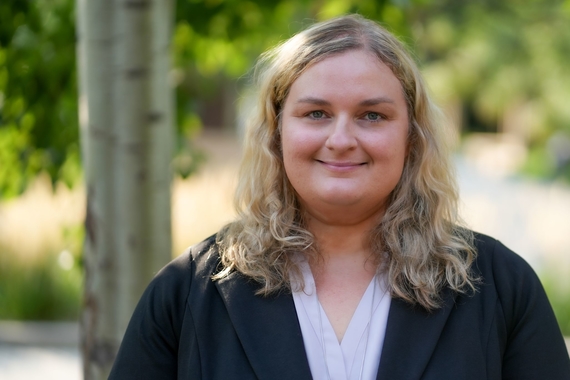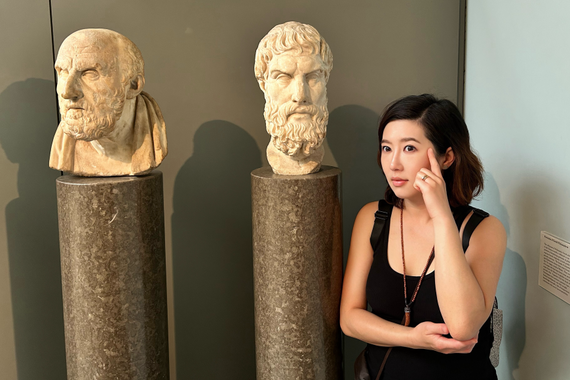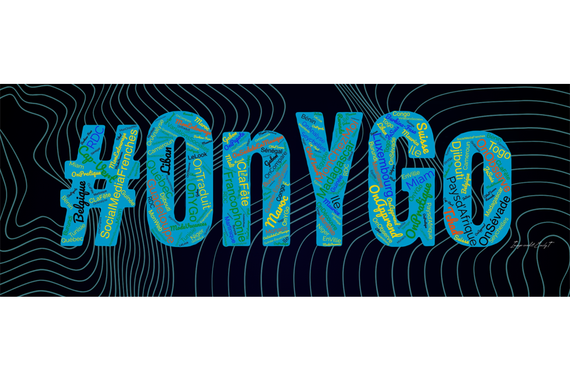The French House: Book Talk with Courtney Lochner at the U
For undergraduate French majors, there is nothing more inspiring than to meet an author who has incorporated her love of French literature and culture into a novel. Courtney Lochner, former French Major and author of The French House (Calumet Editions, Minneapolis, 2022) paid a visit to the University of Minnesota, her alma mater, on a recent evening in April. She was a guest of the Le Cercle Francophone, the student-run organization that sets up events for undergraduate Francophiles. Her novel, which takes place on the campus of the University of Wisconsin (Madison), evokes a very special place for French majors who seek a study abroad experience without leaving the states. French Houses are popular on college campuses across the country, but what makes Courtney’s French House special is the intrigue and mystery associated with it.
Lochner began her book talk with the important date of 1918, the founding of the French House on the U-W campus. She described Wednesday evenings there as devoted to public dinners with “a coterie of intellectual friends.” Her description matches exactly the official one posted online: “a public restaurant for the surrounding community.” Lochner noted that her inspiration for the novel was largely fueled by the fact that she grew up near Madison. However, her fictional French House is noteworthy for its architecture, which does not match the actual building today (see here): “a dark brick mansion at the end of a cobblestone walkway … Intricate as a gingerbread house, it has a turret on its right side, and dormer windows from the third floor” (9). This description is taken from the second chapter, which Lochner read aloud during her visit to the U. In her author’s note at the close of her novel, she reminds readers that U-W’s French House today is constructed “in Frank Lloyd Wright’s prairie style” (283), in stark contrast to the “Victorian home” (283) from long ago. The second time we see the French House up close in the novel, during chapter three, there is again a nod to bygone days, as a female student exits the building in a very chic, retro outfit: “She wore a luxurious black fur bolero over a drop waist ivory dress, black tights with ivory polka dots and oxford heels. She stepped onto campus as if from a different era. She held no phone” (27).
Several descriptions from chapter two got quite a few chuckles from audience members, especially those descriptions expressed in the voices of fictional students. A teaching assistant, Camille, writes a letter describing a French professor’s class as “designed by the devil herself” (7). A random undergraduate student describes the French house to Simone Duchamps, a freshman who is the main character of the novel: “Yeah, a residence hall, but like only for French majors and stuff. … Pretty snooty place. They all keep to themselves” (9). Simone describes her French professor on the first day of class: “Professor Anne Boucher stood before us like a hologram wavering in and out of the light” (11). The narrative voice of Simone constantly reminded audience members where they were in listening to this book talk, though the season was spring, and not fall: “…I found the University of Wisconsin campus exactly as I’d imagined. Like a snow globe outfitted for fall. Cranberry colored leaves scattering across the clear sky, settling over the gothic buildings and students like confetti” (10).
In addition to the architectural details described during the book reading, there was also a great deal of discussion during the Q and A regarding the statue featured on the book’s cover. Lochner talked about how the nudity of the upper torso of the woman resulted in Amazon not wanting to feature the book in its sales at first. The statue by Louis-Ernest Barrias (1899) is entitled “La Nature se dévoilant à la Science” and can be viewed at the Musée d’Orsay. It is particularly striking due to its use of color, and features the following materials, according to the museum’s website: “statue en marbres et onyx polychromes d’Algérie, terrasse en granit gris, scarabée en malachite, ruban en lapis-lazuli.”
The first time we see a similar statue in the novel, it is in an extremely prosaic setting: “…a dead-end street against Lake Mendota, … her profile facing what must have been the only legal parking spot within a five-mile radius” (8). Yet, like its counterpart in France, this statue is the embodiment of mythology through the beauty of the feminine form: “a bronze Aphrodite statue caught my eye—how could she not? She was as great as the Venus de Milo herself, sunlight gleaming off her green skin. Better equipped for the Louvre than for campus, her arms fell to her side with grace, one hand gripping a book” (8). As on the cover, clothing is emphasized in this description of the fictional statue: “She was dressed in a Greek robe, waves of hair rolling down her strong back,…” (8). The statue in the novel is described as having magical powers, in that one must rub it to avoid being cursed (8). The statue has been mysteriously damaged: “How did it break, British pillagers? Frat guys? Maybe that explained the curse” (9). Most fascinating, of course, is that the statue is referred to as “The French House’s statue” (9).
Lochner’s take on the Q and A portion of her book talk matched mine. On her Instagram page she wrote the following: “…I had the honor of doing a book reading and discussion at my alma mater the University of Minnesota hosted by the French Department. It was an evening of intellectual nourishment with excellent questions asked.” Here are some of the other questions:
“Are there really wineries in Wisconsin?”
Answer: Yes, including the Wollersheim Winery and Distillery in Lochner’s hometown of Prairie du Sac, where she is doing a book reading during the month of May.
“What was your motivation in writing this novel?”
Answer: The novel had been in “an office drawer” and was “buried away” for many years. The author associates the first draft of the novel with her maternity leave 10 years ago. She attests to the fact that, “So much of writing becomes editing.” To encourage herself while writing, she told herself that, “Even if no one reads it, I f-ing love it!” She was greatly inspired by reading John Gardner’s On Writing and Writers (2009). This special part of her answer made audience members the most gleeful: “Sometimes it felt like my characters were talking to me at dinner.” Another version of this last answer can be found on the Indie Reader website:
“Is there something in particular that motivates you (fame? fortune?)”
Answer: “I am motivated by characters and settings that appear in my head and tell me their story must be told—and I’m okay with that making me sound a bit looney!”
“Did you read the three books that the professor in the novel says are the most important ones to read in French?” (The novels Les Liaisons Dangereuses and L’étranger, plus the short story La Vénus de l’Ille. These are in fact the titles of the three parts of Lochner’s novel.)
Answer: Yes, and many others in her French courses (“an endless list of French novels assigned,” 12). It is the novel by Camus which really signals for Lochner the notion of the “outsider.” This notion is linked to the idea of the “simulation” going on in the French House, where everyone speaks French without going abroad. The simulation is buttressed by the “foreign exchange students” who live in the French House. Lochner likened the experience of every student living in the French House to that of “a hamster in a cage.” But she also praised those “artistically minded language students” willing to participate in the simulation. Lochner also emphasized that Simone’s friends in the novel might be seen as “misfits.”
"What advice do you have for us, especially as concerns exploring our creativity?”
Answer: “Do something that scares you every day. This is on my kitchen towel. [For example,] brush your teeth with the other hand. Erase the muscle memory. Eat Indian food. Take a tango class. Learn Russian. There needs to be an emotional connection to what we just did. Meet new people, have different conversations.” There was also a reference to Proust’s madeleine and the power of sensations, in particular “the scent of memory.” Her future book project is in fact entitled The Scent of Lost Girls and features a parfumerie (see here). Lochner also favors the sensorial act of dreaming, which she defines as “vetting and filing” things away for later.
After reading the first chapter as a class activity in preparation for the book talk, my students were especially curious about the opening sentences, namely how they set up the remainder of the novel: “They said Alice in Wonderland represented an opium trance. That a man once peeled off his skin during an LSD trip. I’ve heard all sorts of things they said and yet I didn’t know who they were” (3).
Answer: It turns out that Lochner had a great deal to say about psychedelic drugs, but perhaps not in the way audience members were expecting. Not wanting to give away too much of the novel’s plot, suffice it to say that in her “Author’s Notes” Lochner explains that “…I am a journalist for psychedelic therapy and have had the honor of interviewing the field’s top scientists; additionally, I am in the works of directing a documentary about it” (284). I think audience members were hanging onto the edge of their seats when Lochner described her travels to meet “indigenous tribes in the Amazon” and her own personal experiences with “magic mushrooms.” Much was said about medicine as an art form, thus linking medicine and imagination. The author did not shy away from discussing her own personal experiences with psychedelic drugs, affirming this in her “Author’s Notes”: “My own experience with psychedelic therapy was life-changing, and I owe these plants, and this ancient medicinal knowledge, endless gratitude” (284). See the Cosmic Dust Films website for a description of the documentary entitled They Call Her the Mother. Several maladies are evoked (PTSD, anxiety, addiction), while the “psychedelic brew is called ‘The Mother.’”
To find out more about Lochner’s background before becoming a novelist, go here. During her book talk, she referenced her contribution to a collection of essays entitled Europe from a Backpack: Real Stories from Young Travelers Abroad (Pearson Venture Group, 2004). The Kindle version of this collection is a bargain at $2.99. Lochner’s story entitled “Living with an Aristocrat” took place during her junior year of college in Paris. She told her audience that this aristocrat happened to be François Mitterrand’s sister (yes, the former president of France!), though Lochner did not realize the woman’s identity till the end of her stay. Students were also excited to learn that Lochner had won a writing contest sponsored by Glamour Magazine when she was in her twenties. This led to a screenplay for a short film entitled Good Morning Baby (Moxie Pictures, 2005). A clip from the film, directed by Lisa Leone, can be viewed here.
The evening at the U was extra special because it occurred on the very same day that Lochner’s novel was showered with praises. As she exclaimed on Instagram: “On Thursday I learned my novel The French House won the Eric Hoffer New Horizons Award for best new fiction by a debut author AND Best Mystery!” Many of the students gathered at the U that evening already have Lochner’s novel in hand for their summer reading, as she generously did a book giveaway and signing following her talk.

Photo credit: Daniel Tomei, website (used by permission from the photographer and the author; no reproduction without permission). This photo is also featured on Instagram. The author (fourth from the right), me (fifth from the right), and students.

Photo credit: Daniel Tomei, website (used by permission from the photographer and the author; no reproduction without permission). The author writing a personal note to Andrea Arifin (French 1022 student at the U) during the book signing portion of the evening.
I am looking forward to seeing if my students will heed Lochner’s call for creativity in their own lives, as she evoked Marc Humblot’s rejection letter to Proust in 1912 as a parting challenge. The French editor thought it was excessive to take 30 pages to describe falling asleep in Du côté de chez Swann. Lochner shared how her negotiations with a well-known publishing house fell apart when she was told that her novel was “too intellectual” and that it should contain “no psychedelics.”
For their summer reading, the students are especially looking forward to the peppering of French words and phrases throughout the text. When we read Chapter 1 together in class, we discussed the choice of writing a novel in English that includes a smattering of French here and there. We noted that the main character, Simone, referred to her father’s vineyard home as “chez Papa” (3). We noted the easily comprehensible short dialogue between father and daughter: “Dépêche-toi!,” with the response of “J’arrive!” (4). Students appreciated the vulgar use of “Les cons” (5) on the part of the father. They were also fascinated by the extremely philosophical phrase “l’appel du vide” (4). We paused on this last expression a long time in class, as existentialism is always a popular topic among Francophiles! I am looking forward to an impromptu book club with students in the fall, once we finish reading the novel, as there were no spoiler alerts during this fun and inspiring book talk at the U.



